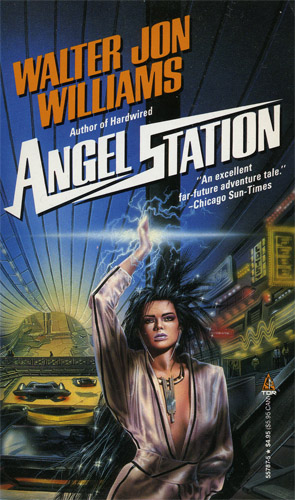Angel Station (1989) is about a brother and sister who own a spaceship that operates on the margins, out on the edges where operations and profits are being squeezed by the big companies. Ubu and Beautiful Maria are down on their luck and just a little desperate when they take a risk and go to Angel Station. If that sounds to you like a set-up for a C.J. Cherryh novel—well, that’s what Angel Station feels like—the grime on the docks, the deals, the hustle. If you like the Union/Alliance books and you wish there were more of them, well, this is the closest it’s possible to get.
It is of course my very favourite kind of book—the kind with spaceships and aliens. It’s just precisely in my sweet spot. And I can’t think of a more purely enjoyable author than Walter Jon Williams. His stories always have well-drawn characters, the ideas are always well thought through, and best of all they’re unfailingly interesting. Even when he writes in genres that don’t especially appeal to me I enjoy his books, and here of course it’s everything I want—if he’d sat down for a month asking himself what I wanted, he couldn’t have come up with a book more to my taste. I’m so glad I already liked him when this came out so I wasn’t put off by the silly cyberpunky cover.
I decided to re-read Angel Station now because of Times Square Red, Times Square Blue and the question of sex districts in science fiction cities. In Angel Station there’s the Fringe, an area of bars and cheap hotels, casinos and entertainment areas that’s used by the systers (insystem crew) and shooters (starship crew) for entertainment and for making deals. The physical Fringe is getting smaller as the freelance part of the economy is getting smaller and the big companies are taking over and cleaning up. The Fringe, on the stations we visit, Angelica and Bezel, feels real. There’s a lot of (female) prostitution going on, as well as cooperative sex. Maria is constantly being approached by pimps with job offers. No doubt there’s just as much going on on the male side, but Ubu with his four arms and general oddness isn’t as appealing. Or maybe there just isn’t, because there isn’t a hint of anything but heterosexuality anywhere. I do wonder why there are so few GLBT characters in fiction. Oh well.
The Fringe is important for more than the sex and the deals, it’s important because it represents the whole way of life Ubu and Maria enjoy and are afraid of losing. It’s where they belong. We see enough of the other side of the stations—the glittering luxury of the hi-liners—to get a contrast, and the settled surface of planets is seen only as a threat. The economy of this future has clearly been thought through in detail, it all fits and makes sense, especially in terms of what happens to it as a result of the plot.
There’s a lot more here. There’s a lovely bunch of aliens, especially our alien point-of-view character, General Volitional Twelve. They’re very well done, alien but comprehensible. There’s a spaceship crew consisting of two teenagers who have skills and abilities of adults but the emotional balance of their real ages. Also on the spaceship is a very cat-like cat, and a holographic ghost of the children’s father, Pasco, appearing at odd times with old recordings of snippets—which is one of the ways we painlessly learn some of the history and context and what’s going on.
In the human society, people are using drugs not only for entertainment but to fine-tune their brains—enhancing particular kinds of intelligence for particular purposes, encouraging concentration and fast-learning skills. Cherryh has drugs for tape-learning, but she doesn’t show people abusing the drugs—Williams does. The drugs are legal, utterly available, and used for lots of purposes, including recreation. There are computers—they’re clear extrapolations of the computers we had in the eighties, no cyberpunk here. Maria, by genetic engineering of psi genes, can feel the electron world and glitch computers—she can also glitch black holes. Writing this down it sounds most implausible, but in fact it’s so well set up that you go along with it step by step.
It’s a great story in a great universe. And it’s complete in itself, that rare thing that people always say they want and then don’t read: a standalone. (And I’m as bad as anyone else. While I’ve enjoyed all the universes he’s written in since, I’ve always hoped he might come back to this one.)
Jo Walton is a science fiction and fantasy writer. She’s published eight novels, most recently Half a Crown and Lifelode, and two poetry collections. She reads a lot, and blogs about it here regularly. She comes from Wales but lives in Montreal where the food and books are more varied.










